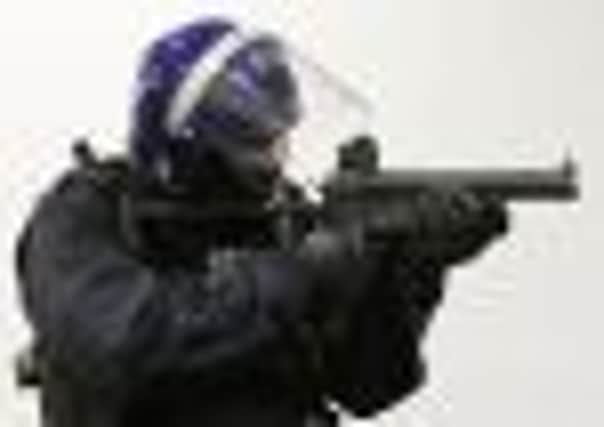Next time, rioters could be shot


The use of firearms could be justified given the “immediacy of the risk and the gravity of the consequences”, legal advice published in the review said.
Plastic bullets and water cannon could also be used by officers facing riots similar to those seen this summer, the review by Her Majesty’s Inspectorate of Constabulary (HMIC) added.
Advertisement
Hide AdAdvertisement
Hide AdPolice need to be better prepared, trained and ready to protect the public if they are to improve their response to similar scenes of violence and looting in the future, the review found.
It called for clear rules of engagement to establish “an agreed envelope of available tactics and associated use of force, that are likely to maintain public support”.
These rules could include making clear that armed police could use firearms with live ammunition during “arson attacks on commercial buildings with linkage to residential dwellings”.
The review added that plastic bullets could also be considered when barricades and missiles were used by protesters, during violent attacks on the public in the presence of police, and when other emergency services are threatened.
Advertisement
Hide AdAdvertisement
Hide AdThey could also be used when petrol bombs are thrown or during arson attacks.
All of these scenes were experienced by officers this summer.
The review added that water cannon were an “effective means of dispersal and incur fewer injuries to the public” in static and slow-moving scenarios.
They are a “good option to protect vulnerable areas and premises”, but it conceded there were none on mainland UK, cost more than £1 million each and need to be deployed in twos to be effective.
Advertisement
Hide AdAdvertisement
Hide AdWater cannon also have to be protected by officers and need access to water as they can empty in “a matter of minutes” if used continuously.
It comes in sharp contrast to a report by the Commons Home Affairs Select Committee yesterday which said it would have been “inappropriate as well as dangerous to have employed water cannon and baton rounds”.
Their use “could have escalated and inflamed the situation further”, the MPs said.
The report said that while current guidance already allowed the use of force, commanders were prevented from using some of the more forceful tactics due to a lack of training and resources.
Advertisement
Hide AdAdvertisement
Hide AdSome forces ran out of shields, not all forces train to use plastic bullets in public order situations, and protective equipment was not always available.
Police also need to outnumber rioters by between three and five to one if they are to effectively move forward, make arrests and disperse groups, the review said.
It found that police training, tactics, equipment and organisation was developed largely to deal with set-piece single- site confrontations, and were not prepared for the widespread, fast-moving and opportunistic criminal attacks seen in August.
But the review also said it would be difficult to justify bringing in soldiers to help tackle riots on the streets.
Advertisement
Hide AdAdvertisement
Hide Ad“It is difficult at present to conceive of a purely public order situation in which the level of force for which the military are currently trained in and equipped to use would be justified,” the report said.
But the military could be used “to take over logistical roles to free police officers for public order duties”.
The HMIC review also called for a “central information ‘all source’ hub”, drawing together all information, including that from direct contact with the public and social networking sites, to be developed.
The review found some officers were “uncertain about the level of force and tactics than can be used lawfully during disorder”.
Advertisement
Hide AdAdvertisement
Hide Ad“Some suggest this uncertainty increased after criticism following the 2009 G20 protests,” the review said.
“Officers recognise that a single act of what could later be regarded as ‘punitive force’ can quickly change the public mood.
“This then is the dilemma public order commanders face.”
One in two members of the public surveyed for the review thought police did not use enough force, while a third thought firearms should have been used against the rioters.
One in four thought police were already using water cannon.
A total of 2,000 people were surveyed between September 16 and 18.
Advertisement
Hide AdAdvertisement
Hide AdSir Denis O’Connor, the Chief Inspector of Constabulary, said: “Some new rules of engagement are necessary so the police can protect the public in confidence.
“People were burned out of their houses.
“We can all remember the woman leaping from the burning building in Croydon.”
Firearms should only be used as a last resort to save a life, but police “ought to be able to consider a range of options”, he said.
The best option was to get officers on the streets as soon as possible, but the question was over what should be done to protect the public while waiting for high numbers of officers to get to the scene, he said.
Advertisement
Hide AdAdvertisement
Hide Ad“We need a proper debate around the tactics the police use.”
He went on: “The general gist of this report is that police have to be able to defend civil order but they need support from the public and others when they do that.
“If we don’t raise some of these awkward issues, then we’re not giving people the chance to prepare for a future where we’re slightly more assured as to what will happen.”
He added that there had been a “long period of peace” where civil order was not top of the agenda, but now it needed to be given priority again.